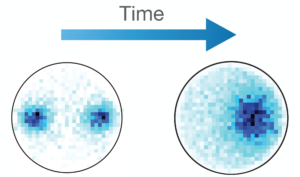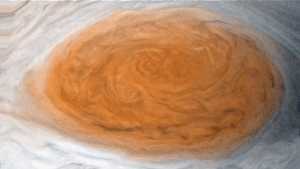
University of Queensland researchers from FLEET and a partner Centre of Excellence experimentally validated a decades’ old vortex theory, with implications for technological applications of superfluid, such as precision sensing.
Eddies in the quantum state known as a superfluid merge to form large vortices, analogous to how cyclones form in the turbulent atmosphere.
Lead author and theorist FLEET Research Fellow Dr Matt Reeves says the team’s results provide experimental validation of the 70-year-old Onsager theory – a model for two-dimensional vortex equilibrium by Nobel Laureate Lars Onsager.
“Large, long-lived vortices like cyclones or Jupiter’s Great Red Spot often form out of turbulent fluid flows, such as the atmospheres of planets,” says Matt.
Onsager’s model explains the existence of these structures, but prior to this 2022 collaborative study with the Australian Research Council Centre of Excellence for Engineered Quantum Systems (EQUS), experiments have tended to conflict with the predictions.
A key complication is that most fluids are viscous, meaning they resist flow. Superfluids, which have no viscosity, are therefore ideal candidates to realise Onsager’s model.

Cyclones, such as Jupiter’s Great Red Spot, are ‘constrained’ in the third dimension (up and down), and thus operate as 2D vortices.
The team studied the behaviour of vortices in a Bose-Einstein condensate, a type of superfluid produced by cooling a gas of rubidium atoms to extremely cold temperatures.
“We created a thin disc of the superfluid and then used lasers to inject vortices at carefully specified locations,” says EQUS researcher Dr Tyler Neely, who led the experiments.
The vortices mixed rapidly, merging into a single large cluster in only a few seconds, much like a large cyclone forming from the turbulent atmosphere.
However, the most exciting thing was the remarkable agreement between theory and experiment – the theory predicted the shape of the final giant vortex structures in the superfluid exceptionally well.
This work answers some of the key outstanding questions from previous work by the team on vortex clusters, which was published in 2019 in Science.
This article first published by ARC Centre of Excellence for Engineered Quantum Systems
Turbulent Relaxation to Equilibrium in a Two-Dimensional Quantum Vortex Gas was published in Physical Review X in February 2022 (DOI: 10.1103/PhysRevX.12.011031.
